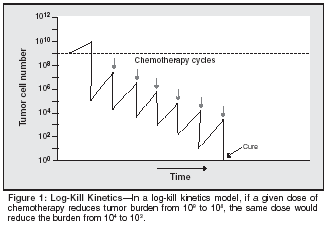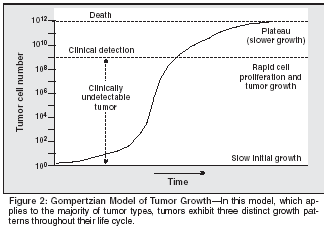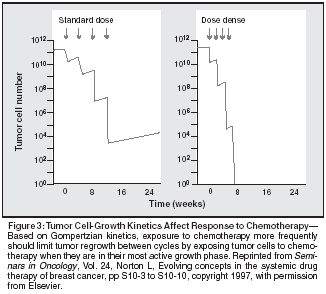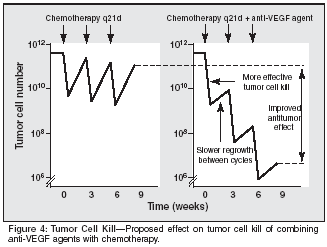Clinical Implications of Antiangiogenic Therapies
The improved survival associated with adding the anti-vascular endothelialgrowth factor (VEGF) monoclonal antibody bevacizumab(Avastin) to chemotherapy for the treatment of patients with metastaticcolorectal cancer demonstrates the importance of targeting collateralcells involved in tumor growth, progression, and metastatic spread.Based on the Gompertzian model of tumor growth, adding anti-VEGFagents to standard chemotherapy may be especially effective in earlystages of cancer. By improving chemotherapy delivery to the tumor andinhibiting regrowth between treatment cycles, anti-VEGF agents mayalter the growth pattern of a tumor such that it is more susceptible toeradication. These concepts also suggest that anti-VEGF agents couldenhance the effectiveness of chemotherapy given conventionally or ina dose-dense fashion. As such, it is possible that the effectiveness ofchemotherapy could be maintained or improved, even at lower cumulativedoses, which may improve its tolerability. Additionally, the effectsof anti-VEGF agents on metronomic chemotherapy, which is reportedto have antiangiogenic properties on its own, warrant further evaluation.Preclinical data demonstrate that cytostatic angiogenesis inhibitorsare potent complementary agents to metronomic chemotherapy,producing sustained complete regressions in some models of humancancer. Dose-dense and metronomic chemotherapy have in common ashortened dosing interval and resultant increased and/or prolongedexposure of tumor cells to chemotherapy in vivo. Optimizing the use ofanti-VEGF agents in the clinic demands further investigation of themost appropriate way to combine them with chemotherapy, particularlyregimens designed to exploit known tumor growth patterns andthose designed to target the endothelial cells involved inneovascularization with multiple agents.
The improved survival associated with adding the anti-vascular endothelial growth factor (VEGF) monoclonal antibody bevacizumab (Avastin) to chemotherapy for the treatment of patients with metastatic colorectal cancer demonstrates the importance of targeting collateral cells involved in tumor growth, progression, and metastatic spread. Based on the Gompertzian model of tumor growth, adding anti-VEGF agents to standard chemotherapy may be especially effective in early stages of cancer. By improving chemotherapy delivery to the tumor and inhibiting regrowth between treatment cycles, anti-VEGF agents may alter the growth pattern of a tumor such that it is more susceptible to eradication. These concepts also suggest that anti-VEGF agents could enhance the effectiveness of chemotherapy given conventionally or in a dose-dense fashion. As such, it is possible that the effectiveness of chemotherapy could be maintained or improved, even at lower cumulative doses, which may improve its tolerability. Additionally, the effects of anti-VEGF agents on metronomic chemotherapy, which is reported to have antiangiogenic properties on its own, warrant further evaluation. Preclinical data demonstrate that cytostatic angiogenesis inhibitors are potent complementary agents to metronomic chemotherapy, producing sustained complete regressions in some models of human cancer. Dose-dense and metronomic chemotherapy have in common a shortened dosing interval and resultant increased and/or prolonged exposure of tumor cells to chemotherapy in vivo. Optimizing the use of anti-VEGF agents in the clinic demands further investigation of the most appropriate way to combine them with chemotherapy, particularly regimens designed to exploit known tumor growth patterns and those designed to target the endothelial cells involved in neovascularization with multiple agents.
Vascular endothelial growth factor (VEGF) is a potent stimulator of angiogenesis. It is expressed throughout the angiogenic process and is crucial for tumor growth and metastatic spread.[1-3] VEGF expression is upregulated in a broad array of tumor types, and this overexpression translates into poorer survival in many human cancers.[4] Given the multiple targets in the VEGF pathway and the potential for improving outcomes in a broad range of human malignancies, numerous anti-VEGF agents are in development. These include antibodies to VEGF, soluble VEGF receptors (VEGFRs), antibodies to some or all of the VEGF receptors, antisense oligonucleotides, and small-molecule inhibitors of VEGFR.[5] One anti-VEGF therapy, a humanized monoclonal antibody to VEGF (bevacizumab [Avastin]), has been approved by the US Food and Drug Administration (FDA). The clinical success (ie, increased patient survival) of this agent in conjunction with chemotherapy in the treatment of patients with colorectal cancer demonstrates that angiogenesis inhibition, and specifically VEGF inhibition, is a viable therapeutic approach.[6] Maximizing the potential of agents that target the VEGF pathway involves investigating a range of doses and administration schedules in combination with chemotherapy.[7] In this article, we explore concepts related to the integration of anti-VEGF agents into chemotherapy regimens and postulate that these agents may alter tumor growth in a manner consistent with the Norton-Simon hypothesis,[8] resulting in improved cytotoxicity, reduced regrowth between cycles, and prolonged survival. Evolving Concepts in Cytotoxicity At the dawn of the modern chemotherapy era, much of the rationale for administering chemotherapy came from kinetic modeling of the response of murine leukemia L1210 to curative chemotherapy.[9] L1210 is a rapidly and almost exponentially growing tumor, with all of its cells progressing through the cell cycle at any given time. The cytotoxic effects of chemotherapy follow log-kill kinetics in this model. If a dose of chemotherapy reduced the tumor burden from 109 to 108, the same dose would therefore reduce the burden from 104 to 103 (Figure 1). Although the vast majority of human tumors have a smaller growth fraction than that of rodent leukemia L1210, this work fostered widely held beliefs that the ratio of proliferating cells to total cells remains constant, tumor growth is logarithmic, and cell kill is proportional regardless of tumor burden. While the exponential growth model is attractive for its simplicity, most human cancers do not exhibit purely exponential growth.[10] Rather, human cancers appear to follow a Gompertzian model of growth.[10] Here, the ratio of proliferating cells to total cells decreases with increasing tumor size. The growth fraction declines exponentially over time, and a plateau phase can be observed in some malignancies.[ 10] As a result, the tumor growth curve has three distinct regions: a slow initial phase, a middle phase characterized by rapid growth, and a slow plateau phase (Figure 2).[10] In a Gompertzian model, chemotherapy, which targets rapidly proliferating cells, kills a small fraction of cells when the cancer is advanced and the tumor is large, but a higher fraction of cells when the tumor is small or when the cancer is clinically undetectable. This explains, in part, the relatively greater effectiveness of adjuvant therapy compared with treatment for metastatic disease.

Another important consideration with Gompertzian growth is the impact of residual tumor cells on tumor regrowth. The regrowth of residual cells is fastest at small tumor volumes, meaning that clinically significant regrowth might occur between cycles of conventionally scheduled chemotherapy. This growth property may explain the challenges inherent in designing curative adjuvant chemotherapy regimens for many types of cancer, including breast cancer. Attempts to eliminate residual disease and improve survival by increasing chemotherapy dose intensity through dose escalation have not proven particularly effective.[11] However, with the advent of colony-stimulating factors, it became possible to decrease the time interval between chemotherapy cycles (dose-dense chemotherapy). Based on his extensive work with Gompertzian kinetics, Norton proposed that administering an appropriate and effective dose of chemotherapy more frequently would limit tumor regrowth between cycles, thereby providing a more effective way of treating residual disease (Figure 3).[11] Building on a series of pilot studies, the Cancer and Leukemia Group B (CALGB) tested this hypothesis in Intergroup trial C9741.[12] In this randomized clinical trial, treatment with dose-dense chemotherapy improved survival relative to standard chemotherapy when administered in the adjuvant setting for the treatment of patients with node-positive breast cancer. Treatment was generally well tolerated. Severe neutropenia was less common for patients in the dose-dense arm, who received prophylactic colonystimulating factor support with each cycle as part of the treatment regimen. With the proof of principle established, other cooperative group trials are currently including dose-dense chemotherapy in randomized trials, eg, Southwest Oncology Group (SWOG) trial 0221, National Surgical Adjuvant Breast and Bowel Project (NSABP) trial B-38, and CALGB 40101. Dose-dense chemotherapy has been hailed as an important incremental advance in treatment for early-stage breast cancer.[13] Results from additional trials are needed to determine the ability of dose-dense chemotherapy to improve survival for patients with other malignancies.


Chemotherapy Combined With Anti-VEGF TherapyPotential Effects on Tumor Growth Patterns
The Norton-Simon hypothesis predicts that the addition of any effective anticancer agent to chemotherapy could produce improved results by limiting tumor regrowth between cycles. Anti-VEGF agents are not believed to be cytotoxic on their own, but rather inhibiting tumor growth through their effects on neoangiogenesis is one underlying mechanism of action.[6] Specifically, anti-VEGF agents are thought to starve tumors by inhibiting their ability to maintain newly developed vasculature and to recruit a blood supply. These steps are necessary for continued tumor growth.[3] By altering the growth pattern of the tumor and preventing regrowth of a regressing tumor, the addition of anti-VEGF agents to chemotherapy regimens may result in improved clinical outcomes, without requiring a reduction in the chemotherapy dosing interval. Moreover, anti-VEGF agents likely enhance the cytotoxic effects of chemotherapy. Anti-VEGF therapy has been demonstrated to normalize the disorganized and dysfunctional tumor vasculature, resulting in increased intratumoral chemotherapy levels.[14,15] In addition, the demonstrated ability of anti-VEGF agents to reduce the high interstitial fluid pressure of the tumor[16] may result in improved chemotherapy delivery to the tumor center where this pressure is highest.[17] By improving chemotherapy delivery to the tumor, anti-VEGF agents could increase tumor cell kill rates. In the pivotal trial conducted in patients with colorectal cancer, survival was improved for patients receiving IFL (irinotecan [Camptosar], fluorouracil, leucovorin) chemotherapy plus bevacizumab relative to those receiving IFL alone.[6] Theoretical tumor regression curves illustrate the hypothesis that adding anti-VEGF agents alters the tumor growth pattern, improves intratumoral chemotherapy delivery, and results in improved rates of minimal residual disease and possibly disease eradication (Figure 4). Dose-Dense Chemotherapy Combined With Anti-VEGF TherapyPotential Therapeutic Synergies
There are provocative theoretical reasons to evaluate the combination of anti-VEGF agents and dose-dense chemotherapy. Dose-dense therapy is being applied in the adjuvant setting because the mathematical cell kill curves suggest greatest benefit with early intervention. Similarly, VEGF may be especially important during the early stages of neoplastic progression.[ 18,19] Because VEGF signaling is a rate-limiting step for tumor angiogenesis, the use of anti-VEGF agents early in the course of disease and prior to the development of metastases would be expected to yield the greatest benefit. In theory, anti- VEGF agents would aid in keeping tumor volumes small, while dosedense chemotherapy would eradicate the small but mitotically active residual tumor cells. Another possible synergy between dose-dense chemotherapy and anti- VEGF agents relates to the induction of VEGF expression. Dose-dense chemotherapy may increase the proportion of tumor cells undergoing mitosis while it reduces tumor burden through its cytotoxic action. Hypoxia occurs during rapid tumor growth and is a signal for the tumor to produce VEGF.[20] In the absence of anti- VEGF agents, it is possible that dosedense chemotherapy could actually increase signals for tumor angiogenesis. Treatment with anti-VEGF agents could counteract any increase in VEGF levels found in the tumor environment as a result of rapid cell growth and hypoxia. Overall, it is likely that the cell-kill curve produced by an anti-VEGF/dose-dense chemotherapy regimen would be steeper than that by chemotherapy alone, which could result in the eradication of residual disease with fewer courses of therapy. Potential Effects of Chemotherapy on Angiogenesis
Another intriguing hypothesis is the possibility of synergy between anti-VEGF agents and chemotherapy, with respect to the inhibition of angiogenesis. Chemotherapy likely targets dividing endothelial cells found in newly forming blood vessels; however, these cells are relatively slow growing, and conventional cycle lengths may allow for repair and recovery from some of the chemotherapy- induced damage.[21] Researchers have devised antiangiogenic or metronomic chemotherapy dosing schedules in order to apply continuous pressure on the newly forming tumor vasculature and possibly overcome acquired chemotherapy resistance.[ 21,22] This approach involves either continuous chemotherapy infusion or regular, frequent chemotherapy administration, generally with lower chemotherapy doses to avoid excess toxicity. Indeed, there is evidence in humans that this approach overcomes drug resistance, as patients resistant to conventional taxane therapy have been found to respond subsequently to lower-dose weekly treatment.[23]

In animal models, metronomic chemotherapy has generally produced tumor control, including regression in chemotherapy-resistant models.[ 21,24,25] However, superior results have consistently been seen in these models when metronomic chemotherapy was combined with a putative angiogenesis inhibitor, such as TNP-470 or experimental anti-VEGF antibodies.[21,24-26] Indeed, complete, sustained regressions were seen in a neuroblastoma model and a lung cancer model when metronomic chemotherapy and angiogenesis inhibitors were combined.[21,24] Combined antiangiogenic therapy has been taken a step further by Pietras and colleagues, who evaluated a combination of standard chemotherapy followed by metronomic chemotherapy with multitargeted inhibition of VEGF and pericytes (through platelet- derived growth factor receptor [PDGFR] inhibition).[27] Given the pronounced efficacy of the combination in this murine model of neuroendocrine cancer, they proposed a clinical trial schematic consisting of standard chemotherapy followed by maintenance therapy with an oral, lowdose chemotherapeutic agent plus bevacizumab to target the endothelial compartment and imatinib (Gleevec) to target the pericytes, which along with endothelial cells are important regulators of blood vessel formation and function. Evaluating Chemotherapy and Anti-VEGF Combinations in the Clinic The possibility that anti-VEGF agents enhance dose-dense and metronomic chemotherapy warrants evaluation in clinical trials. The effect of bevacizumab on metronomic lowdose cyclophosphamide (Cytoxan, Neosar)/methotrexate therapy is currently being evaluated in a randomized phase II trial in women with metastatic breast cancer.[28] Similarly, the combination of low-dose continuous oral cyclophosphamide plus bevacizumab is under investigation in women with metastatic or recurrent ovarian cancer.[7] Additional data may be needed before moving forward with dose-dense chemotherapy and anti-VEGF combinations in randomized clinical trials. For example, given the potential for anti-VEGF agents to enhance intratumoral chemotherapy concentrations, it may be possible to reduce the dose of chemotherapy when given in combination with these agents. Reduced- dose chemotherapy could improve the tolerability of dose-dense regimens, and perhaps even obviate the need for routine CSF support. Furthermore, reduced-dose, dosedense chemotherapy with anti-VEGF agents may begin to resemble metronomic therapy, producing enhanced cytotoxicity through improved delivery to the tumor and enhanced and prolonged targeting of the endothelial compartment. A logical dose-dense regimen with which to evaluate combined therapy with anti-VEGF agents is dose-dense doxorubicin/cyclophosphamide followed by paclitaxel, as used in Intergroup trial C9741.[12] The benefits of this regimen have been demonstrated in patients with node-positive, operable breast cancer. Moreover, research suggests a role for anti-VEGF agents in breast cancer. VEGF is highly expressed in breast carcinomas,[29] and VEGF expression is a prognostic marker in breast cancer in that it is correlated with decreased relapse-free and overall survival.[1,30,31] Indeed, bevacizumab monotherapy has shown promising activity in metastatic breast cancer in a phase I/II trial, although data are currently lacking in the adjuvant setting.[32] Of note, recent data from a phase III trial comparing capecitabine with or without bevacizumab in heavily pretreated patients with metastatic breast cancer showed significant improvement in overall response rate.[33] However, overall survival was not increased in the bevacizumab arm. Results from studies such as Eastern Cooperative Oncology Group (ECOG) trial 2100, a randomized trial comparing paclitaxel with or without bevacizumab in first-line treatment of metastatic breast cancer, will help identify the clinical benefit of bevacizumab and will likely guide patient selection for future clinical trials.[34] In addition, evaluation of bevacizumab in combination with metronomic and dose-dense chemotherapy regimens will provide key information that can be used to optimize the therapeutic benefits of anti-VEGF agents. Conclusion The success of bevacizumab in the treatment of patients with metastatic colorectal cancer demonstrates the utility of targeting a tumor's collateral support system rather than the tumor itself. The mechanism of action of anti-VEGF agents suggests that these agents complement traditional chemotherapy regimens in a way that could especially augment the most effective existing regimens such as dosedense therapy. There is evidence that frequently administered chemotherapy enhances the antiangiogenic activity of bevacizumab and that bevacizumab enhances the cytotoxic effects of chemotherapy. The clinical development of anti- VEGF agents represents a major opportunity for the evaluation of novel combination regimens in a broad range of tumor types. Optimizing the use of anti-VEGF agents will require additional studies that evaluate how best to integrate these agents into chemotherapy regimens, particularly those designed to achieve maximal benefit in the Gompertzian model of tumor growth and those designed to maximize the antiangiogenic potential of chemotherapy itself. The potential for maintenance metronomic/antiangiogenic therapy to potentiate the effects of standard chemotherapy is also worthy of further evaluation.
Disclosures:
Dr. Hudis has received research support and honoraria from and acted as a consultant to Amgen, AstraZeneca, Aventis, Bristol-Myers Squibb, Genentech, Novartis, Pfizer, and Roche.
References:
1. Relf M, LeJeune S, Scott PA, et al: Expression of the angiogenic factors vascular endothelial cell growth factor, acidic and basic fibroblast growth factor, tumor growth factor beta-1, platelet-derived endothelial cell growth factor, placenta growth factor, and pleiotrophin in human primary breast cancer and its relation to angiogenesis. Cancer Res 57:963-969, 1997.
2. McMahon G: VEGF receptor signaling in tumor angiogenesis. The Oncologist 5(suppl 1):3-10, 2000.
3. Bergers G, Benjamin LE: Tumorigenesis and the angiogenic switch. Nat Rev Cancer 3:401-410, 2003.
4. Ferrara N, Davis-Smyth T: The biology of vascular endothelial growth factor. Endocr Rev 18:4-25, 1997.
5. Bergsland EK: Vascular endothelial growth factor as a therapeutic target in cancer. Am J Health Syst Pharm 61(suppl 5):S4-S11, 2004.
6. Hurwitz H, Fehrenbacher L, Novotny W, et al: Bevacizumab plus irinotecan, fluorouracil, and leucovorin for metastatic colorectal cancer. N Engl J Med 350:2335-2342, 2004.
7. Bergsland E, Dickler MN: Maximizing the potential of bevacizumab in cancer treatment. The Oncologist 9(suppl 1):36-42, 2004.
8. Norton L, Simon R: Tumor size, sensitivity to therapy, and design of treatment schedules. Cancer Treat Rep 61:1307-1317, 1977.
9. DeVita VT Jr: Principles of cancer management: Chemotherapy, in DeVita VT Jr, Hellman S, Rosenberg SA (eds): Cancer: Principles and Practice of Oncology, 5th ed, pp 333- 347. Philadelphia, Lippincott-Raven, 1997.
10. Norton L: Implications of kinetic heterogeneity in clinical oncology. Semin Oncol 12:231-249, 1985.
11. Norton L: Evolving concepts in the systemic drug therapy of breast cancer. Semin Oncol 24(4 suppl 10):S10-3-S10-10, 1997.
12. Citron ML, Berry DA, Cirrincione C, et al: Randomized trial of dose-dense versus conventionally scheduled and sequential versus concurrent combination chemotherapy as postoperative adjuvant treatment of node-positive primary breast cancer: First report of Intergroup Trial C9741/Cancer and Leukemia Group B Trial 9741. J Clin Oncol 21:1431-1439, 2003.
13. Hudis CA, Schmitz N: Dose-dense chemotherapy in breast cancer and lymphoma. Semin Oncol 3(3 suppl 8):19-26, 2004.
14. Wildiers H, Guetens G, De Boeck G, et al: Effect of antivascular endothelial growth factor treatment on the intratumoral uptake of CPT-11. Br J Cancer 88:1979-1986, 2003.
15. Willett CG, Boucher Y, di Tomaso E, et al: Direct evidence that the VEGF-specific antibody bevacizumab has antivascular effects in human rectal cancer. Nat Med 10:145-147, 2004.
16. Lee CG, Heijn M, di Tomaso E, et al: Anti-vascular endothelial growth factor treatment augments tumor radiation response under normoxic or hypoxic conditions. Cancer Res 60:5565-5570, 2000.
17. Heldin CH, Rubin K, Pietras K, et al: High interstitial fluid pressure-An obstacle in cancer therapy. Nat Rev Cancer 4:806-813, 2004.
18. Ferrara N, Gerber HP, LeCouter J: The biology of VEGF and its receptors. Nature Med 9:669-676, 2003.
19. Rugo HS: Bevacizumab in the treatment of breast cancer: Rationale and current data. The Oncologist 9(suppl 1):43-49, 2004.
20. Semenza G: Targeting HIF-1 for cancer therapy. Nat Rev Cancer 3:721-732, 2003.
21. Browder T, Butterfield CE, Kraling BM, et al: Antiangiogenic scheduling of chemotherapy improves efficacy against experimental drug-resistant cancer. Cancer Res 60:1878- 1886, 2000.
22. Hanahan D, Bergers G, Bergsland E: Less is more, regularly: Metronomic dosing of cytotoxic drugs can target tumor angiogenesis in mice. J Clin Invest 105:1045-1047, 2000.
23. Kerbel RS, Klement G, Pritchard KI, et al: Continuous low-dose anti-angiogenic/metronomic chemotherapy: From the research laboratory into the oncology clinic [editorial]. Ann Oncol 13:12-15, 2002.
24. Klement G, Baruchel S, Rak J, et al: Continuous low-dose therapy with vinblastine and VEGF receptor-2 antibody induces sustained tumor regression without overt toxicity. J Clin Invest 105:R15-R24, 2000.
25. Klement G, Huang P, Mayer B, et al: Differences in therapeutic indexes of combination metronomic chemotherapy and an anti- VEGFR-2 antibody in multidrug-resistant human breast cancer xenografts. Clin Cancer Res 8:221-232, 2002.
26. Bello L, Carrabba G, Giussani C, et al: Low-dose chemotherapy combined with an antiangiogenic drug reduces human glioma growth in vivo. Cancer Res 61:7501-7506, 2001.
27. Pietras K, Hanahan D: A multitargeted, metronomic, and maximum-tolerated dose “chemo-switch” regimen is antiangiogenic, producing objective responses and survival benefit in a mouse model of cancer. J Clin Oncol 23:939-952, 2005.
28. ClinicalTrials.gov website: Metronomic low-dose cyclophosphamide and methotrexate with or without bevacizumab in treating women with metastatic breast cancer. Available at: http://www.clinicaltrials.gov/ct/show/ NCT00083031. Accessed March 1, 2005.
29. Yoshiji H, Gomez DE, Shibuya M, et al: Expression of vascular endothelial growth fac- tor, its receptor, and other angiogenic factors in human breast cancer. Cancer Res 56:2013- 2016, 1996.
30. Linderholm B, Lindh B, Beckman L, et al: The prognostic value of vascular endothelial growth factor (VEGF) and basic fibroblast growth factor (bFGF) and associations to first metastasis site in 1307 patients with primary breast cancer (abstract 13). Proc Am Soc Clin Oncol 20:4a, 2001.
31. Sledge GW Jr: Vascular endothelial growth factor in breast cancer: Biologic and therapeutic aspects. Semin Oncol 29(suppl 11):104-110, 2002.
32. Cobleigh MA, Langmuir VK, Sledge GW, et al: A phase I/II dose-escalation trial of bevacizumab in previously treated metastatic breast cancer. Semin Oncol 30(5 suppl 16):117- 124, 2003.
33. Miller KD, Chap LI, Holmes FA, et al: Randomized phase III trial of capecitabine compared with bevacizumab plus capecitabine in patients with previously treated metastatic breast cancer. J Clin Oncol 23:792-799, 2005.
34. National Cancer Institute (NCI) website: Phase III randomized study of paclitaxel with or without bevacizumab in patients with locally recurrent or metastatic breast cancer. Available at: http://cancer.gov/clinicaltrials/view_ clinicaltrials.aspx?version=healthprofes sional&cdrid=69156. Accessed March 1, 2005.